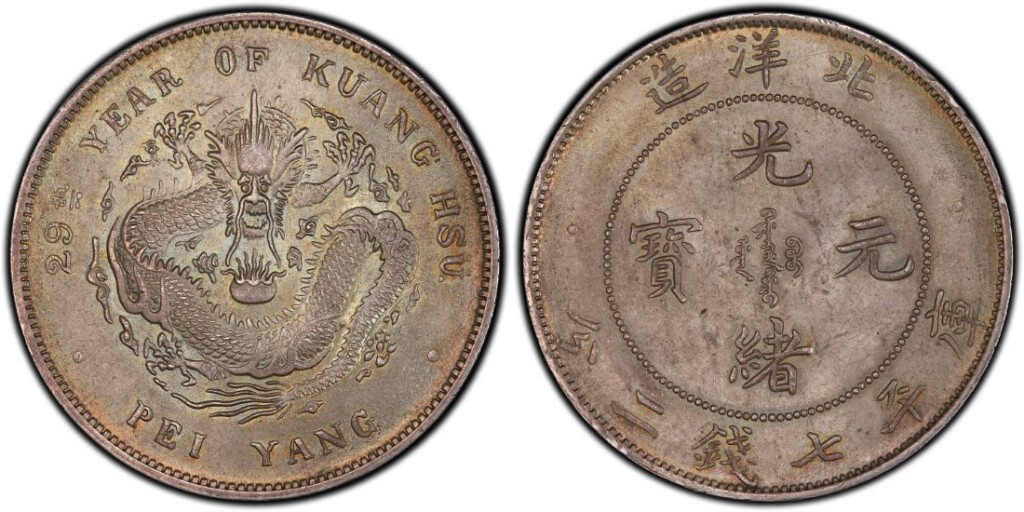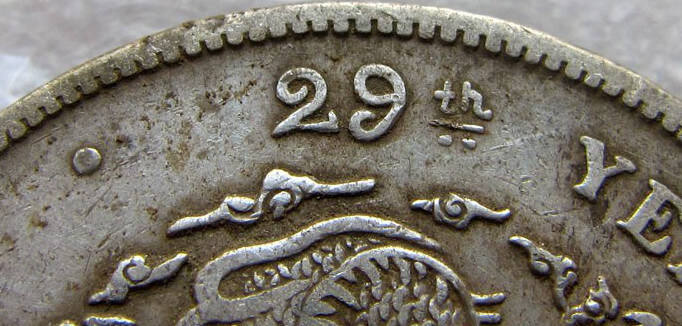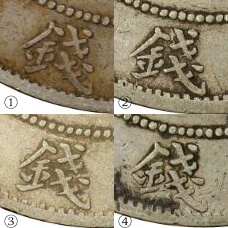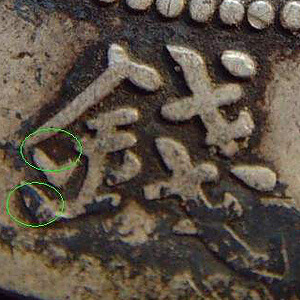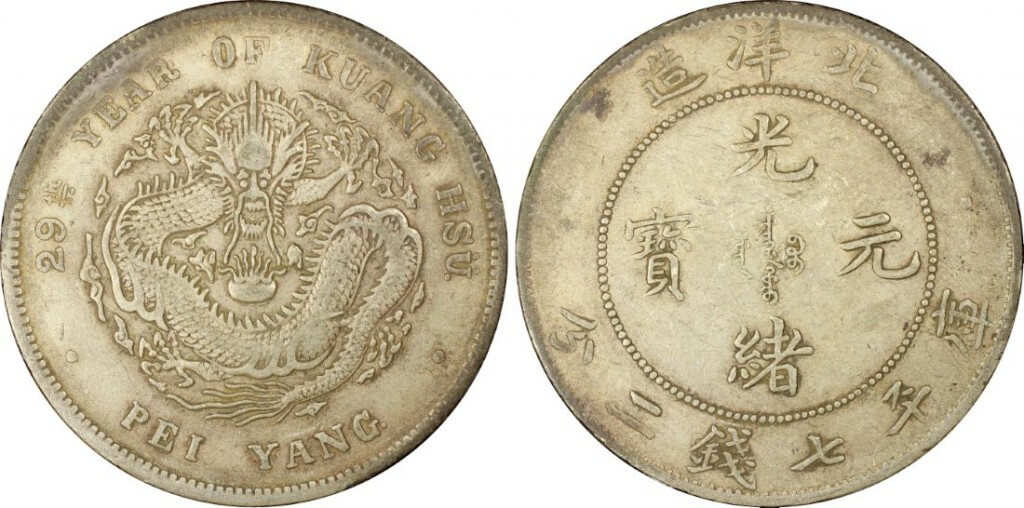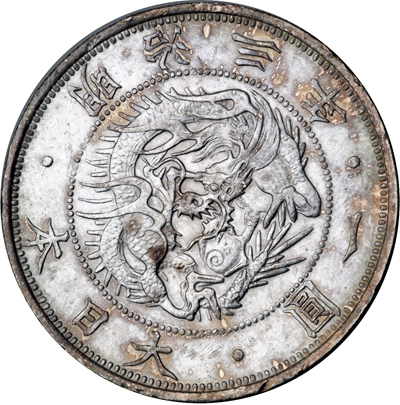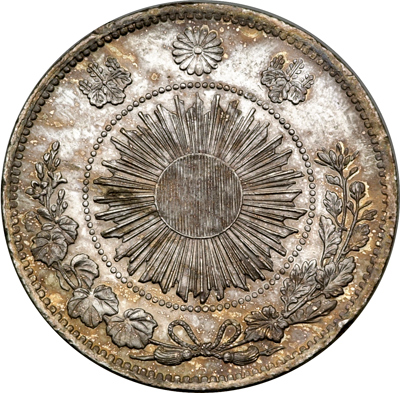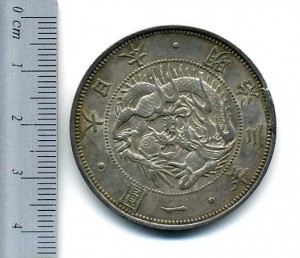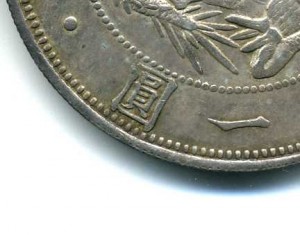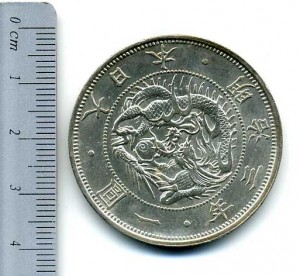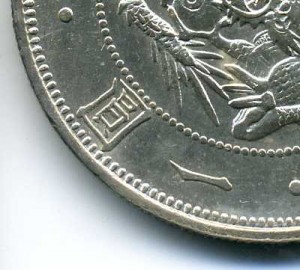The 1903 Chihli dollar (Y73.1) is much scarcer than its sister Chinese silver dollar, the famous Y73.2 made in 1908 (see related articles), but it is also somewhat less studied. Currently, only the variety with a full-stop after PEIYANG is acknowledged by grading agencies. There exists actually much more interesting and rare varieties, which are actively sought after in China. Similarly to the 1908 Chihli dollar, this 1903 dragon coin has been minted in several version with different typography for the date. The most dramatic is the 艺术字 (artistic font):
Besides the roman numerals, another device to examine carefully is the 錢 character on the reverse of the coin. On the full-stop after PEI YANG coins, the 金 part (radical) on the left of the 錢 character has been calligraphied in four different ways:
The picture 1 is representative of what you see on 90% of Y73.1 dragon dollars: this is the most common variety. The calligraphy shown on picture 3 is called 中折金 and is much scarcer: both side strokes of the 金 radical are curved in a very noticeable way. Even more rare, the 挑金 variety (picture 2) is easily identified by its incurved left stroke. The rarest of all the varieties is the 双折金, with characteristic vigorous tapered strokes on the side and bottom (see picture 4 and details).
If like me you collect Pei Yang 29th year Chinese silver dollars, be on the lookout for these rare varieties: while they enjoy some popularity in China, most collectors abroad are still unaware of them, so there is good opportunities around.
There is a dragon on this coin, and it is covered in Chinese characters, therefore several readers assumed it was a Chinese coin… This is actually a Japanese coin. Subsequent strikes of this type of coin include an English face value of “One Yen“, which helps avoiding this mistake, but the coin above is a one year type, with no English legend at all, making its proper identification somewhat more tricky if you are unable to read Chinese characters. While the focus of this blog is clearly Chinese coins, I thought it could be interesting to write an article about this particular dragon dollar.
The strike of western-style round coins began earlier in Japan than in China: the coin above was minted in 1870, the year of the currency reform edicted by the Emperor Meiji (also known by his personal name, Mutsuhito). Seeking to modernise the country and bring it to western standards of the time, the Emperor Meiji replaced the ancient and complicated monetary system by a bi-metallic, western-style currency backed by gold and silver to facilitate trade with foreign countries. Due to the round shape of the dollar sized coins, the new currency was called “Yen“, using the same traditional Chinese character 圆 (Yuan) than in China. The symbol was later simplified as 元 in China, and 円 in Japan, which are now respectively used as the Yuan and Yen currencies symbols.
On the obverse, the coins depicts the Japanese dragon holding the pearl of wisdom. One can note that while the Chinese imperial dragon has always 5 claws, this Japanese dragon has only 3 toes. In Japan as in China, the Emperor was said to be the descendant of dragons. In China, the story goes that dragons originated in China and lost toes as they went farther and farther, until they could not walk anymore. This is why the Korean dragon has 4 claws and the Japanese dragon 3 toes. But there is a long time rivalry between China and Japan, and in Japan people say that dragons actually came from Japan, and grew more claws as they went further away…
The reverse is actually more helpful for identification purpose: it shows the characteristic rising sun symbol and the imperial seal of Japan, a 16 petals chrysantemium flower.
This dragon dollar is known in western catalogues as Y5, type 1 or type 2. But what is the difference between these “types”? This information is surprisingly difficult to find online. There is actually 3 main versions of the 1870 Japanese yen, which only differ in the way the 圆 character was written. The most common is the type 1, as shown at the beginning of this article.
The type 2, also called “正貝円” in Japan (正贝元 in China), is much scarcer. The difference resides solely in a tiny detail of the 圆 character: on the common version, the left stroke at the bottom of the 貝 part of the character is too short, incomplete. On the type 2, the stroke is longer, complete – that is why this type is called “Correct 貝 Yen”.
There is also a third version, very rare and expensive, called “欠貝円” in Japan (“Defective 貝 Yen”). The 圆 character on this die variation is lacking one stroke, effectively creating a yawning gap in the middle of the character.
There is more die variations (手変わり in Japanese) of the early Yen coins, but they are minor and have less impact on the price than the 3 shown above.
The Meiji 3 silver yen is one of the scarcest Japanese coins, however it is still much cheaper than a lot of Chinese coins. You can buy a mint state type 1 1870 Yen for about $1000 USD at current prices.
